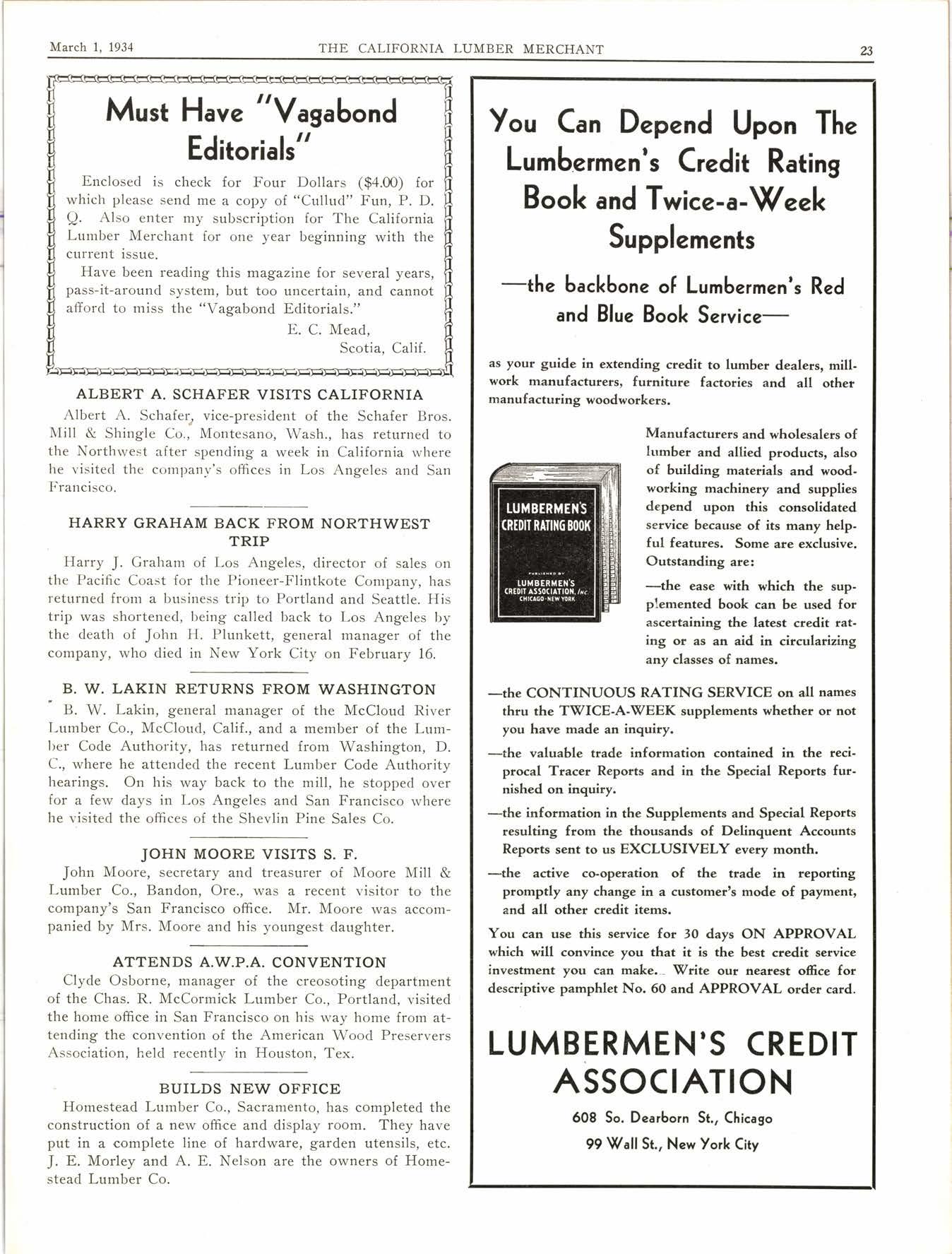
3 minute read
Lumber Stocks Still Excessive
Productio n Exceeded Consumption in 1933
Washington, D. C., Feb. 11.-While the first quarter of 1934 promises a large demand for lumber in certain fields' according to the Lumber Survey Committee of'the U' S. Timber Conservation Board, lumber stocks are still 2.6 billion feet too large. This opinion is set forth in a statement which has been submitted to the Department of Commerce. Conservative adjustment of produ'ction is therefore recommended.
The report dwells on the importance of cultivating the export market and of active promotion of the lumber trade at home. Substantial recovery of the lumber industry will not be attained it says, until farm purchasing power increases and private building is actively resumed. While Iumber consumption increased during 1933, as compared .rith 1932, production ran slightly ahead of it.
Inventory reduction is emphasized as a means of strengthening the ability of the lumber industry to operate under the conditions imposed by the Lumber Code.
The Lumber Survey Committee appointed on July 9, 1931, consists of Thomas E. Holden, Vice President, F. W. Dodge Company, New York; M. W. Stark, Economist, Chicago, Ill.; Calvin Fentress, Chairman of the Board, Baker, Fentress & Company, Chicago, Ill.; Dr. Wilson Compton, Secretary and Manager, National Lumber Manufacturers Association; and Axel H. Oxholm, Chief, Forest Products Division, Department of Commerce. This Committee serves voluntarily in cooperation with the work of the Timber Conservation Board in its study of the economic situation in the forest products industries.
I. CONCLUSIONS AND RECOMMENDATIONS
The Lumber Survey Committee makes the following findings and recommendations:
1. The total national lumber stocks are in aggregate surplus by approximately 2.6 billion feet. Although the first quarter of 1934 promises continuation of a large demand for lumber, in view of public works requirements, the launching of a nation-wide drive to revive home building, and steadily increasing purchasing power along a wide front, private building and farm construction which norrnally represent a large proportion of lumber demand, are not yet in substantial recovery. Conservative planning and output, therefore, are again indicated as desirable.
2. It has been repeatedly urged by industry leaders that trade promotion efforts are essential along with production control and planning. Most of the critical code problems are due to inadequate volume of demand. Increased sales efforts on the part of American exporters may restore in part at least the loss in the lumber export trade, which in 1933, is estimated to have been 60 per cent below that oi 1928. The last few months of 1933 show advances in lumber exports over the earlier part of the year and over 1932, the rise, however, being due to amelioration of world economic conditions and the exchange situation rather than to efforts on the part of the American lumber industry. Not only is there a large potential market for lumber in the export field but in domestic lines lumber manufacturers will be out-stripped by their many alert competitors unless more attention is paid to research and promotion.
3. Information on shortages and surpluses in lumber stocks is still fragmentary. Reports show shortages in rnany items but generally a surplus in shop and factory grades.and, in some regions, in box items. Further analysis of reports is shown on page 10. Exchanges of stocks by manufacturers in order to avoid unnecessary accumulations should be continued.
4. The general advance in prices at the lumber mills which had been much moderated during the past quarter has ceased. The Bureau of Labor Statistics.shows for lumber the greatest proportionate increase over a year ago, of any major building material; just as it had also shown the greatest proportionate decline during the precedirig three years. Comparison with 1926, for example, indicates that the general lumber price level has regained most of the heavy losses of the past few years, while at the same time the average costs have been greatly increased under drastic code provisions.
5. Cooperation of lumber manufacturers with the Forest Service and Census Bureau is urged in the efiort of these bureaus to secure lumber statistical information. The nation-wide surveys of lumber consumption in construction and the wood-using industries, recommended in our last report, is now under way at the Forest Service. Due to curtailed funds the Census Bureau is handicapped in its canvass for lumber production figures for 1933 which will continue its yearly series begun 3O years ago. A large part of this handicap will be removed if lumber manufacturers will respond promptly to the Census schedules sent out in January. Without these basic figures, the statistical work under code authorities is necessarily incomplete'
6. The Timber Conservation Board should make, or cause to be made, further periodic surveys and reports on current and prospective lumber demand and supply, with suitable recommendations.
Looks For Improvement
W. W. Peed of the Los Gatos Lumber Co., Los Gatos, recently in San Francisco on a business trip, said he looks for a steady improvement in the retail lumber business from now on. Mr. Peed was formerly manager of the Monterev Bav Redwood Co.
Sales Manager Calls On Trade
Jas. E. "Jimmy" Atkinson, district sales manager of the Chas. R. McCormick Lumber Co., San Francisco, was back at his desk February 24 after spending two weeks with two of the company's salesmen, calling on as many yards as time permitted. He spent a week traveling with Jerry Stutz in the San Joaquin Valley, and a week with E. G"Dave" Davis in the Sacramento Valley.









